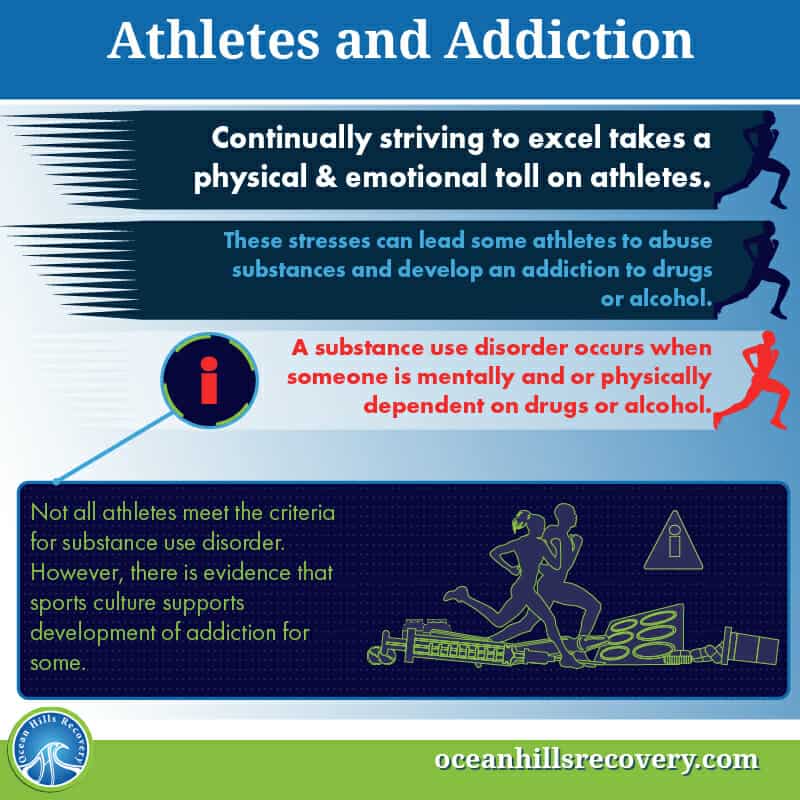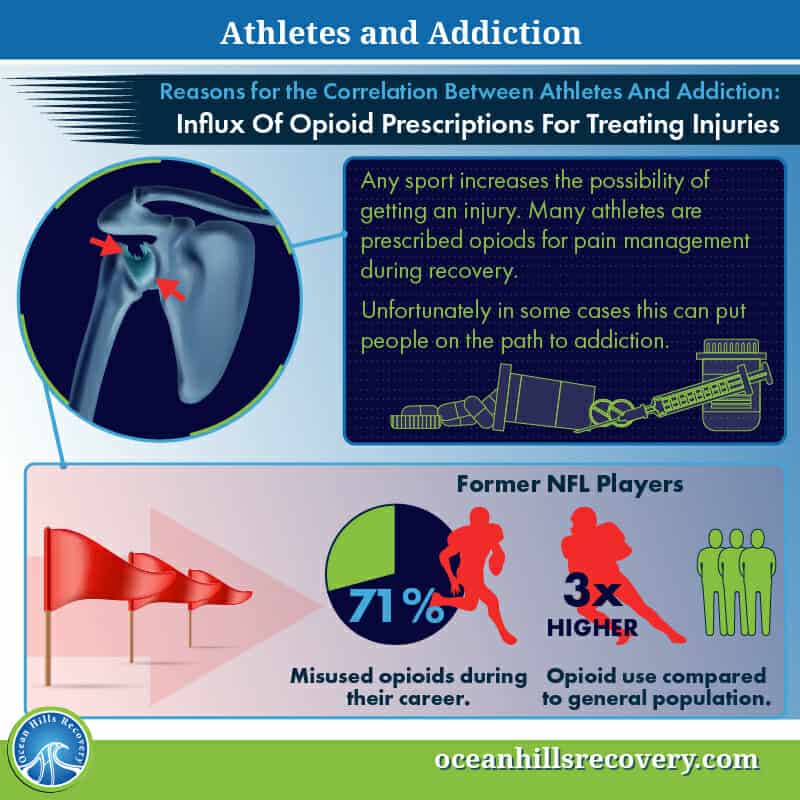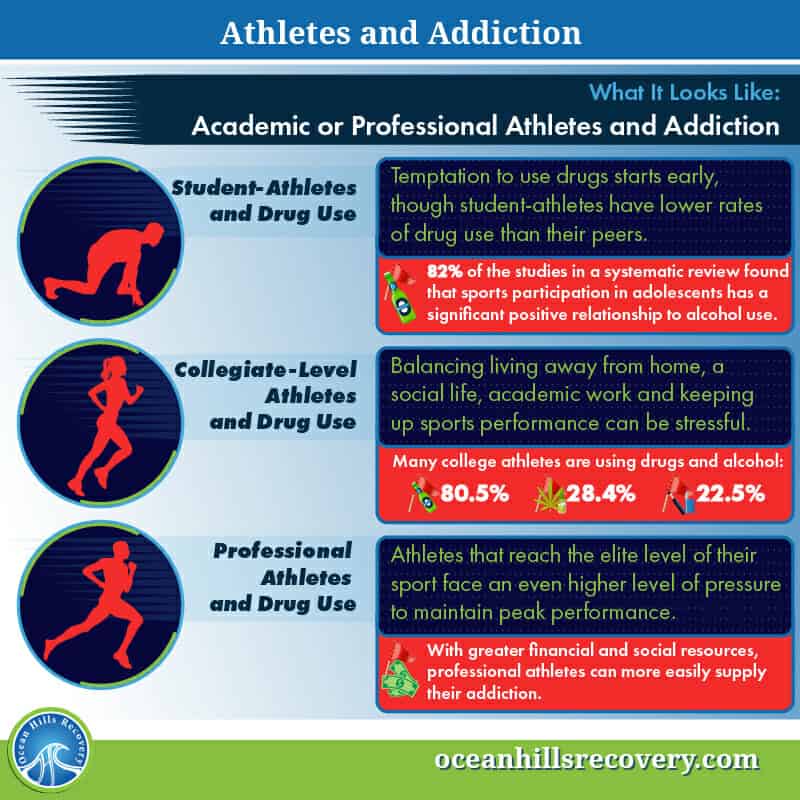The emotional and physical toll that it takes to excel as an athlete is extensive. Often, athletes push themselves to the limit to achieve their fitness goals and reach perfection, a feat that doesn’t come without its struggles. One of the many struggles that both student and professional athletes face is the risk of addiction to drugs and alcohol.
Let’s explore the reasons behind the complicated relationship between athletes and addiction.
Continued after video:
3 Factors That Help Explain The Correlation Between Athletes And Addiction
A substance use disorder occurs when someone is mentally and or physically dependent on drugs or alcohol. Not every substance-using athlete meets the criteria for this disorder. However, there is no doubt that unhealthy relationships between athletes and drugs are all too familiar. Research has even found that some individuals find the sports culture to support the development of addictions.1
Some of the reasons that explain why many athletes spiral into addiction include the following:
#1: Struggles Coinciding with Mental Health Issues
The pressures to perform, stay in ideal shape, and avoid injury are a few of the many factors that play a role in an athlete’s declining mental health. More specifically, one study on elite Canadian athletes found that 41.4% met the criteria for one or more mental health disorders.2 Another statistic reveals that one-third of Division 1 NCAA female athletes are at risk of the eating disorder anorexia, a dangerous mental illness.3
Many individuals who have mental illness use drugs and alcohol to cope with their symptoms. 18.2% of those in the United States with a mental illness are also struggling with some kind of substance use disorder.4 Since many athletes have struggled with mental health, they are also likely to use substances for coping.
#2: Influx Of Opioid Prescriptions For Treating Injuries
Any sport increases one’s susceptibility to getting an injury. Whether it’s a torn ACL, broken bone, sprained ankle, or another painful injury, many athletes are prescribed opioids to cope with the pain during their recovery.
This leads many on a path to addiction, for one study on former NFL Players found that 71% misused opioids during their career.5 Furthermore, their current amount of opioid use was 3x higher than the general population.5
#3: The Desire To Improve One’s Sports Performance
One of the traps that many athletes fall into with drug use is using them to improve their performance. Whether it’s taking anabolic steroids to increase their muscle mass or a stimulant drug to give them more adrenaline on the day of their game or event, the pressure of performing at the highest caliber possible to beat out the competition can lead to the abuse of these harmful drugs.
When it comes to using steroids for improving strength, research indicates that 9% of professional football players have used anabolic steroids at some point in their career and a shocking 67% of competitive lifters.6
What It Looks Like: Academic or Professional Athletes and Addiction
Whether a seasoned pro or just an up-and-coming student-athlete, drug use can occur at all stages of an athlete’s journey. Here is an overview of what drug use might look like for three levels of athletes:
Student-Athletes and Drug Use
The temptation for athletes to start using starts quite young. While student-athletes might have lower rates of using some drugs than their peers, 82% of the studies in a systematic review found that sports participation in adolescents has a significant positive relationship to alcohol use.7
Collegiate-Level Athletes and Drug Use
Collegiate-level athletes have to balance adjusting to living away from home, a social life, and academic pressures to perform well in sports. This is a recipe for heightened stress and the risk of drug abuse. Research studies found that many college athletes use alcohol (80.5%), marijuana (28.4%), and smokeless tobacco (22.5%).8
Professional Athletes and Drug Use
When athletes have reached the elite level of playing sports, they often have added stress to perform well and more financial and social resources to supply their addiction. This is shown in the countless famous athletes who have openly discussed their struggles with addiction publicly.
Build Your Substance-Free Future With An Ocean Hills Recovery Partnership
If you or an athlete you know is struggling with addiction, Ocean Hills Recovery is available for anyone 18+. We offer both inpatient and outpatient treatments and we are sure to have a drug and rehab program that fits your unique needs.
Are you ready to take back control over your life? Then contact our professional staff today.
Sources:
[1] https://www.sciencedirect.com/science/article/abs/pii/S1469029216301819?via%3Dihub
[2] https://www.sciencedirect.com/science/article/abs/pii/S1469029221001369?via%3Dihub
[3] https://www.nationaleatingdisorders.org/eating-disorders-athletes
[4] https://www.drugabuse.gov/drug-topics/trends-statistics/infographics/comorbidity-substance-use-other-mental-disorders
[5] https://www.ncbi.nlm.nih.gov/pmc/articles/PMC3095672/
[6] https://www.ncbi.nlm.nih.gov/pmc/articles/PMC4140700/
[7] https://pubmed.ncbi.nlm.nih.gov/24290876/
[8] https://pubmed.ncbi.nlm.nih.gov/11176146/


















